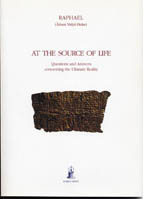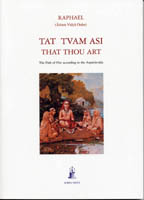|

Raphael
AT THE SOURCE OF LIFE
Questions and answers about the Ultimate Reality
This volume is a collection of questions and answers involving Raphael and an audience interested in the “quest”. The dominant note calls the attention of the reader to the origin of conflict and consequent human sufferings. Conflict-suffering is essentially the result of the difference between what man has and is and what he would like to have and be. When between these two possibilities there is perfect accord, conflict cannot arise.
In giving his answers Raphael involves the questioner in the search and discovering of the Ultimate Reality. He gives stringent and convincing demonstrations that urge the questioner to recede from the thinking process, to draw further and further away from “appearances”, until he is left with no support. Some answers may seem bold, but we must consider the fact that Raphael assumes the Advaita standpoint.
The second part of the book includes 116 sutras by Raphael about the “Path of Fire” that are a consequential stimulation to realize what has been presented in dialogue form in the first section.
CONTENTS: Foreword – The ideal of man – True love – The enemy of man – The limits of the mind – We are the children of desire – What is Absolute Reality – Evolutionism – The Master – The Awakened – Advaita – Subject and object – What is time? – Immortality and Bliss – There are several paths – Occultism and psychical powers – Art – Contemplation of action – Jivanmukta – Brahman – Freedom and slavery – Education – Projection – Solution – Path of Awakening – Analytical Index.
approx. 140 pages
Raphael
BEYOND DOUBT
Overcoming the fears and illusions of individuality
Often the individual is assailed by doubts, uncertainties, suspicions that are the inevitable consequence of a reduced and veiled awareness. The individual lives outside of himself thus forgetting his real nature and alienating himself in the object.
Human beings are sailing on a dark sea without a compass and fail to discern the lighthouse that marks the end of the journey. Some affirm that no signpost or lighthouse of salvation exist and they plunge into the great sea of life, blindly dulling their senses with pleasure-sorrow; others dialectically state that salvation means the glorification of the ego and individualism; still others maintain that the human being can gain freedom by removing the haze of ignorance and by directing his arrow towards the realization of Being. This is the way that leads us to the transcendence of the ego so as to find ourselves again as universal reality.
Raphael stimulates the reader to discover himself and to find in himself the path leading him “beyond doubt”.
Of particular interest are the chapters: Vibrating Life and Post Mortem and Bardo Thötröl; in the first there is a presentation of a vision of Life from the point of view of Harmony; in the second the essence of the teaching included in The Tibetan Book of the Dead is explained in a way which proves valid and acceptable by the western mind.
CONTENTS: Foreword – Sensorial materialism – Philosophy of Being – Karma, sadhana and culturalism - Points of view and erudition – Original sin and Christianity – Transformation of consciousness and techniques – Name, form and vasanas - Vibrating life – Asparsa yoga – Post mortem and Bardo Thötröl – Ahamkara – Separation – Akasa and meditation – Dying to oneself.
approx. 170 pages
Raphael
THE PHILOSOPHY OF BEING
A conception of life to escape the difficulties
of individual and social conflict
A group of people belonging to different political ideologies, but all with a need for realization, met together pressed by the same questions: can politics, as generally practised, solve the fundamental problems of the individual? Can it really eliminate differences at social level and bring humanity to a peaceful state of cooperation and welfare? Are political ideologies, in their basic motivations, truly valid? Can there be a political philosophy capable of meeting both the psycho-spiritual needs of the individual and the contingent-material ones of social policies? If a change is required, what should be changed, how and where should change be directed?
These problems, as well as others, are discussed in this book by Raphael in the light of the Philosophy of Being, or Philosophia perennis, in its adaptation to the socio-political order. This Philosophy proposes a radical change of the cause and not of the effects. From this standpoint the book, although touching on problems of metaphysical realization, can prove very useful to those who are in search of a Vision in conformity with the ontological Principle and want to live according to the principles of the “right action” in the world of becoming.
CONTENTS: Foreword – Projection-idol – Social orders – Final freedom – Peace and co-operation among classes – Doing one’s duty – Overcoming discursive thought – Philosophy of Being – Traditional art – Shadows over gurus and traditional culturalists – Floggers and executioners – Initiation and rite – Solution of the energetic aggregate.
approx. 200 pages
Raphael
TAT TVAM ASI
THAT THOU ART
The Way of Fire according to Asparsa vada
This book consists of a “realization dialogue” between Antonio, a seeker after the ultimate Reality, and Raphael, a true Asparsin.
Antonio has gone through many different experiences but he has failed to find a solution to his existential problems. He then meets Raphael who points out to him the “Way of Fire” according to Asparsa vada, For this “Way” the human being, in its essence, cannot but be the Absolute itself: conflict, sorrow, struggle and violence exist because the individual, forgetful of his true nature, lives without rather than within himself. Hence the most profound message given by the Upanishad (Vedanta) to restless man: Tat tvam asi, That thou art, a mantra that represents the synthesis of the Advaita and Asparsa Teaching.
This work will undoubtedly benefit those readers who are truly and eagerly in search of freedom and are not looking for dialectic, discursive supports but for an active and operative path capable of transforming the consciousness and of restoring the “dignity of being”.
CONTENTS: Foreword – Sensorial life is conflict – What is meant by Reality – Advaita Vedanta – Shankara – Triple knowledge – Asparsa yoga – Brahman saguna – Maya: apparent motion – Evolutionism – Unity of Tradition – Bodily death – Harmony – The qualifications of the disciple – Jung and western extroversion – Sadhana – How the subconscious is formed – Transmigration – Compensations of the ego – Dying to oneself – Being in the world but not of the world – Glossary.
approx. 150 pages
|
|
|


